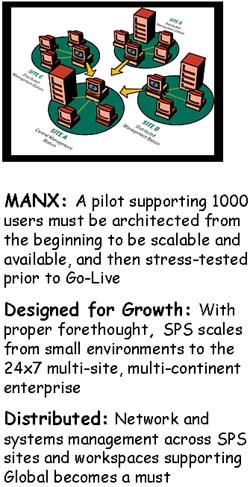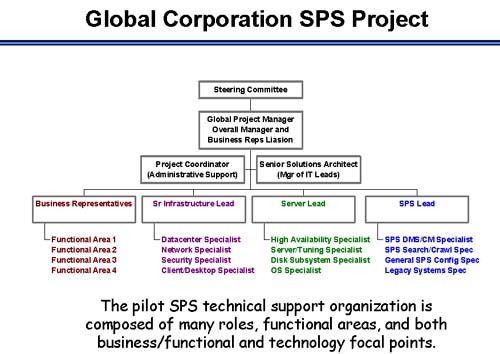| Central to driving an enterprise Portal implementation is understanding and addressing the sheer level of solutions-stack complexities, from network infrastructure to server and disk subsystem infrastructure, up through the operating system, database, SharePoint Portal Server, potential integration points, client requirements, and more. In the next few pages, we look at some of the more critical staffing and technical challenges in detail (see Figure 22.3). Figure 22.3. Some of the concerns and requirements of implementing a large SPS Pilot project are illustrated here.  Staffing Challenges Before a single business need can be addressed, or a technical challenge be conquered, a staffing plan must be created and filled by Global. Global, like most companies, is constrained in terms of availability of high-end business and IT folks. That is, the good ones tend to already be consumed by other key projects. However, the Project Steering Committee felt like it was more important to identify the roles that needed to be filled, and to worry about how to actually fill them later. In terms of an approach, it made sense for the Global Steering Committee folks to "whiteboard" the SPS solution stack, and start assigning priorities and responsibilities. After a quick hour , the following technical support organization for implementing SPS became clear (see Figure 22.4): -
An SPS Pilot Project Manager was needed, to put the project into the hands of a capable resource with knowledge and experience in project management, as well as sheer bandwidth, to make the pilot a success. -
Two to three business representatives, tasked with riding out the entire SPS Pilot project, were identified as critical success factors. That is, the project would only be a win if business needs were indeed addressed. -
A senior collaboration/document management solutions architect would be required, and would in many ways help the PM to lead the other IT specialists assigned to the project. -
Various IT specialists would obviously be required, including folks skilled in designing highly available IT solutions, server and disk subsystem hardware, the Windows 2000 operating system environment, network infrastructure, client/desktop configurations, system security, and of course SharePoint Portal Server installation and configuration. -
To reduce the burden of day-to-day administrative tasks like time-keeping, scheduling, expense tracking, setting up client and business-focused data collection interviews, and so on, a Project Coordinator was also deemed critical. Figure 22.4. Global's technical support organization addresses both business and technology roles, and provides management and leadership to both of these areas individually and as a project team.  It quickly became apparent to Global that they could not wait for the best internal resources to become available. Thus, the budget was "grown" to allow for bringing in consultants and other contractors into key positions that could not be filled in a timely manner with Global folks. The one position everyone on the Steering Committee agreed could not be outsourced was the Project Manager, though. In the end, the Solutions Architect and a few of the technical specialists were brought in from a Microsoft Solutions Provider skilled in deploying SharePoint Portal Server across complex enterprises . CAUTION Don't be tempted to outsource a Project Coordinator. Such a role is best served by a long-time employee of the company, someone intimately familiar with how to get things done inside the company, such as how to work around the red tape found inside even the most efficient of institutions.
Connectivity Architecture Challenges Not only does traditional data center “centric network infrastructure come into play in regard to solutions architecture, so does simple browser or client access. In other words, both back-end and front-end network requirements must be addressed in a successful SPS deployment. High availability can be achieved back at the data center, typically through redundancy. In terms of client access, though, speed more than strict availability is emphasized . Front-end accessibility is no less critical, though, for without it, the Portal ceases to serve any purpose. Client/Browser Requirements Accessibility refers to simply being able to access data from a browser or client perspective. Fortunately for Global's pilot project, everyone is running a supported release of Internet Explorer. And by the time the SharePoint Portal Server implementation has truly "gone global," the remaining Global Corporation users will also be enjoying their new SharePoint-supported client environment. Most Portal implementations will not be so fortunate from a client perspective. In these cases, subprojects geared at elevating client installations to a minimum-supported level will be both required and customary.  For minimum client requirements, refer to "System Requirements for Clients," p. 37. For minimum client requirements, refer to "System Requirements for Clients," p. 37. Note that access through a SharePoint Portal Server dashboard site does not require the SPS client install, but rather consists of a minimum version of Internet Explorer. Global determined that this access mechanism, a browser-based strategy, would be employed for the bulk of SPS Pilot users. Upgrade Versus New Client Purchase One rule of thumb for many IT support organizations is that client upgrades (desktops, laptops, whatever) do not pass the "ROI" test if more than 3 “4 hours must be spent performing services related to upgrades. In those cases, it makes better financial sense to simply deploy a new client complete with Windows 2000 Professional or newer , Office 2000 or (preferably) Office XP, Internet Explorer 5x+, and so on. Think about it. These upgrade services include tasks related to identifying hardware and software revisions, mapping these to the minimum requirements mentioned previously, and performing the actual hardware or software upgrades (including scripting, or creating SMS or similar "automated" installation/upgrade packages). A typical hard-disk upgrade, therefore, almost immediately warrants a new client installation. Connectivity to the Portal Finally, enterprise accessibility means having connectivity ”that is, a network link ”that enables productive use of the Portal. This becomes such a huge issue for enterprise deployments ”where perhaps hundreds or thousands of users are network-bandwidth constrained ”that we have dedicated a section later in this chapter for "physical challenges" related to network connectivity. Availability/High ”Availability Requirements In a small workgroup or departmental solution, it is likely that the Production system consists of one or two servers and a small number of disk drives and other resources set up to provide a certain level of high ”availability, such as 99% or so uptime. Windows of planned downtime are usually quite abundant in these cases ”perhaps 8 hours every evening, and 48 hours of planned downtime every weekend , might be available each week! Enterprise Availability An enterprise solution will tend to have more stringent uptime requirements than its departmental or small business unit colleague, due to the following: -
Greater number of users or business groups tends to force smaller windows of planned downtime. -
Users across multiple time zones force even smaller windows of planned downtime. The sun never sets on quite a few worldwide Production Portal implementations. At the same time, other forces are at work: -
Larger data requirements tend to push backup times out longer, typically shrinking the time available for users to access the data. -
Large data stores underscore the importance of the data itself and therefore emphasize the ability to restore it quickly should the need (or a disaster!) occur. -
Large data stores drive larger indexes, and therefore tend to inherently slow down access to the data in the Portal. -
SharePoint Portal Server does not support Microsoft Cluster Server as of this writing. Therefore, the highest levels of availability must be pursued through other technical product/configuration means. The net effect of the preceding is that great importance is placed on the system in terms of when it is actually available to be used. Thus, driving maximum availability is essential. To that end, proper change control is paramount. By the same token, great weight should be given to protecting the data that resides on the Portal. Duplicating each Production portal becomes a minimum requirement, as does providing a minimum level of data protection at a hardware level. For example, RAID-protected data and OS drives should be a minimum requirement for Production-level SharePoint Portal Servers. The fact that SharePoint Portal Server does not support Microsoft's clustering technology should not read as an admission on Microsoft's part that high availability is not important. Instead, this fact should only serve to reduce the number of high availability alternatives; many others exist, from cloning disk drives, to maintaining off-site server duplicates, to utilizing third-party clustering technologies. In the end, an exercise in the cost of downtime is all that is required to determine your specific needs, driving your options accordingly .  |